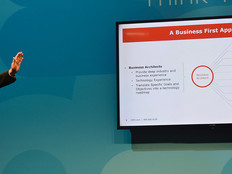The Keys to Overcoming Hurdles to Digital Transformation
Although the Internet of Things is reshaping industries as diverse as energy and retail, and digital technology is helping businesses achieve more revenue, most businesses are not transforming their IT to take advantage of the digital, connected world that awaits.
There’s a variety of reasons for that, according to Link Simpson, the IoT and digital transformation practice lead at CDW. Those hurdles include insufficient budgets, a lack of buy-in from business leaders, not enough IT talent and data security concerns.
Speaking at CDW’s “Transforming the Customer Experience with Digital Modernization” summit in New Orleans, Simpson said that businesses can overcome these challenges by developing a strategic vision for how the business wants to transform. He also noted that companies should start small on pilot projects to get more buy-in from key leaders and other employees and work with partners to make the process less complex and daunting.
Although $6 trillion is expected to be spent on IoT by 2021, yielding between $3.9 trillion to $11.1 trillion per year in economic impact by 2025, most businesses are having trouble getting started on their digital transformations. According to research released last year by Vanson Bourne and Dell, only 19 percent of the 4,000 business leaders it surveyed across the globe were either leading on digital transformation or had a mature digital plan.
IoT involves the instrumentation of the physical world with sensors, and analytics can sift through that data for insights, Simpson noted. In contrast, digital transformation involves using IoT and IT to change business models — better cost efficiency and return on investment, lower costs and improved customer experience and business processes.
“Disruptive change is hard,” Simpson said. He also noted that some companies are waiting to see how new technologies like IoT evolve.
SIGN UP: Get more news from the BizTech newsletter in your inbox every two weeks!
The Stumbling Blocks on the Road to Digital Transformation
There are five key hurdles that CDW sees businesses facing when it comes to adopting digital transformation, Simpson said. One is a lack of executive support for disruption, which includes a lack of a top-down push for new technologies. It also includes a lack of vision. “If there is not the big, broad, bold vision, it’s not going to move as fast as it should either,” he said.
Secondly, even if business leaders want to embrace new technologies, they sometimes face a lack of budget or resources to aggressively adopt them.

CDW's Link Simpson discusses how businesses can undertake digital transformation. Photo credit: Phil Goldstein
Another reason is a lack of skills and expertise to make the technologies a reality, he said. According to a recent survey released by Canonical, 68 percent of the IoT professionals, developers and vendors it surveyed are struggling to find and recruit employees with relevant IoT expertise. “We see a lot of organizations that don’t have the expertise around the IoT component,” Simpson said.
Some companies might not feel like their technology is up to speed, he added. “They really believe that they’ve got to get a lot of their groundwork done, get the foundation in place before they can move forward,” he said.
The fifth reason is security concerns, Simpson said. These concerns tend to arise when connecting more sensors and devices, which generates more data that then needs to be protected.
Overcoming Barriers to New Business Models
Simpson said it is important to separate IoT from digital transformation, and adopting IoT technologies should not be the “endgame” for companies. “The endgame is how do you change your business; how do you transform that business with all of that new information?” he said.
Fundamentally, digital transformation is broader than IoT and is a business-first approach, Simpson said. “It’s all about creating business outcomes and results in terms of improving efficiency, gaining new insights, changing the customer experience, establishing differentiation for your organization, and [it’s] ultimately about how do you create new models that can disrupt and change your industry as a whole,” he said.
According to Simpson, digital transformation is inherently complex since it involves new business goals and processes, existing IT infrastructure, new sensors and data, cloud services to move data, specialized analytics, comprehensive security, and new support and integration services.
To effectively manage all of that, Simpson recommended that businesses work with strategic partners. “Don’t go it alone,” he said. Most IT teams spend about 70 percent of their time simply maintaining existing systems and may not have time to focus on new technologies. A partner can help bring expertise to bear on a business’s specific market and also bring together the needed hardware, software and services in a simplified way.
However, part of working with a partner is laying out a vision that the partner can use to help the business. Only business leaders know the company’s goals, challenges, existing IT infrastructure and culture, Simpson said. Companies need to take that into account as they plan their digital transformations. “You’d be surprised by how many people we see diving into this world without the proper planning,” Simpson said. “The old saying of ‘if you don’t know where you’re going, it’s pretty tough to get there,’ it’s true.”
CDW helps companies plan digital transformation journeys with Envisioning Workshops, which help map how to move forward on a strategic vision.
Businesses should also use a standard model of deploying IoT solutions to future-proof other solutions. For example, a layered approach of physical devices and controllers, connectivity, edge computing, data accumulation, data abstraction, applications, and collaboration and processes can help businesses reproduce IoT deployments down the road.
Finally, Simpson said, with a plan and architecture in place, businesses should start small by “implementing relevant, focused solutions.” Businesses should try to get easy wins by making high-value changes to their technology that are not complex. “That’s going to let you get a political win, it’s going to let you get some value early in the process, and that’s going to give you the momentum to really reinvest those dollars or move forward with additional planning,” Simpson said.
Those early wins will also increase buy-in from executives and other employees and help start to change the organization’s culture, he said. “These focused solutions that are very specific to your industry and your needs are really important,” Simpson added. “Pick something that you know others in the industry are already seeing success with — so you’re not really trying any science projects, you’re not really stepping out on a limb too far from a risk standpoint.
“Pick something that will work because you know that it’s worked at [other companies] in your industry, and you know it will give you some significant value for your business in the near term.”








